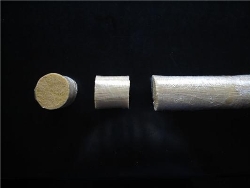Jan 5 2010
The fourth Empa Innovation prize, with its 5000 Swiss Franks endowment, has been awarded this year to Josef Kaufmann, Joern Luebben und Walter Trindler. Together with fiber specialist Eugen Schwitter of industrial partner fibrotec ag, Mollis, they have developed a novel fiber made of two different synthetic materials which when used with concrete gives the building material additional ductility.
 A packet that makes concrete more ductile: the newly developed fibers are supplied in a “Power Packet” that is simply added to the wet concrete
A packet that makes concrete more ductile: the newly developed fibers are supplied in a “Power Packet” that is simply added to the wet concrete
Concrete can be thought of as synthetic stone, and is of course frequently used as a building material. It consists of a mixture of gravel, sand and water bound together with cement. Whilst concrete, when cured, can withstand high compressive loads, it fails when subjected to even low tensile forces. Concrete first became useful as a building material when this disadvantage was overcome by the use of steel reinforcing, since the steel takes up any tensile loads which occur.
Fibers replace steel mesh
Wherever the reinforcement of concrete elements with thick, heavy steel mesh is not necessary – for instance for thin cellar walls, industrial flooring, cement slabs, sprayed concrete, tunnel cladding elements, window sills and so on – the impact resistance and flexural strength of the material can be improved by the addition of steel fibers. Steel fibers however, suffer from serious disadvantages; they can rust, they are stiff (and so present an injury hazard) and heavy. Synthetic fibers, on the other hand, represent the ideal alternative. If the aim is only to prevent shrinkage cracks in the concrete then in fact cheap fibers with limited mechanical properties are sufficient to do the job. For more demanding requirements, to date is has been necessary to use fibers of special (and therefore expensive) polymer materials.
In a project supported by the Innovation Promotion Agency (CTI), Empa physicist Josef Kaufmann and his team together with their industrial partner, the fiber manufacturing company fibrotec ag, have developed an economical polymer fiber which can withstand high mechanical loads. They were assisted by a new production process which allows the manufacture of fibers made of two components. The trick is that the core of the newly developed fibers is made of economic polypropylene (PP) whilst only the thin fiber sheath is made of a special, tailor made polymer which is chemically and mechanically ideally suited for use in building materials using a cement binder.
The path to market readiness was, however, a long one. First, a suitable “recipe” for the polymer had to be found. The next step was to optimize parameters such as surface structure, fiber diameter and length, and the ratio of sheath thickness to core diameter. The various fiber prototypes developed during the project work were tested in Empa’s Concrete/Construction Chemistry Laboratory.
The final product – a “power packet”
In order to simplify use and ensure the correct dosage the fibers are supplied in a “power packet” which the concrete manufacturer or mixer truck operator merely has to add to the wet mixture. The packing dissolves during the mixing process, the individual fibers are set free and they are distributed evenly throughout the mixture. “We use five kilos of synthetic fiber to replace thirty kilos of steel fibers, and at the same time our bicomponent fibers cost about ten percent less than conventional steel fibers,” says Josef Kaufmann.
Source: http://www.empa.ch/